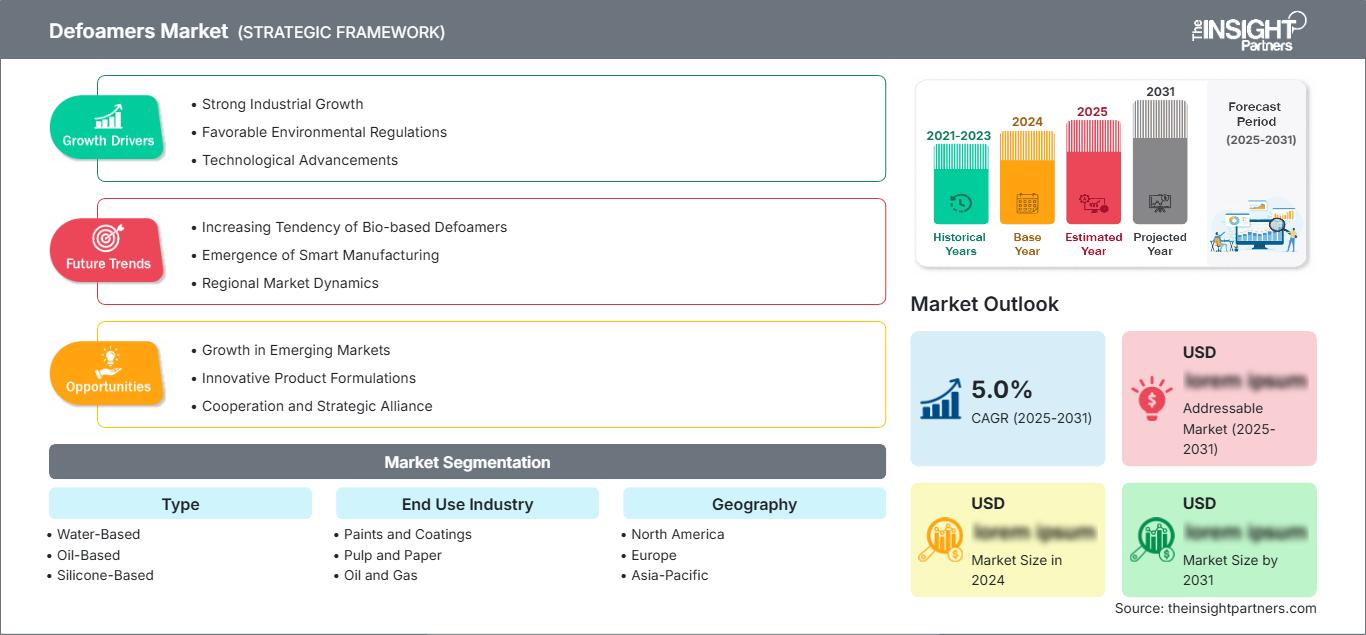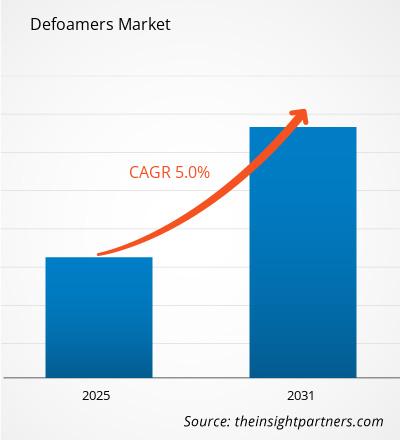Si prevede che il mercato degli antischiuma registrerà un CAGR del 5,0% dal 2025 al 2031, con una dimensione del mercato in espansione da XX milioni di dollari nel 2024 a XX milioni di dollari entro il 2031.
Il mercato degli antischiuma è segmentato per tipologia, settore di utilizzo finale e area geografica. In base alla tipologia, il mercato è segmentato in prodotti a base d'acqua, a base di olio, a base di silicone e altri. In base al settore di utilizzo finale, il mercato è segmentato in vernici e rivestimenti, cellulosa e carta, petrolio e gas, alimenti e bevande, tessile, farmaceutica, metalli e altri. L'ambito del rapporto copre cinque regioni: Nord America, Europa, Asia-Pacifico, Medio Oriente e Africa, America Meridionale e Centrale e i paesi chiave di ciascuna regione. L'analisi globale è ulteriormente suddivisa a livello regionale e per paesi principali. Il rapporto offre il valore in USD per l'analisi e i segmenti sopra indicati.
Scopo del rapporto
Il rapporto "Antifoamers Market" di The Insight Partners mira a descrivere il panorama attuale e la crescita futura, i principali fattori trainanti, le sfide e le opportunità. Ciò fornirà spunti a vari stakeholder aziendali, come:
- Fornitori/Produttori di tecnologia: per comprendere le dinamiche di mercato in evoluzione e conoscere le potenziali opportunità di crescita, consentendo loro di prendere decisioni strategiche informate.
- Investitori: per condurre un'analisi completa delle tendenze in merito al tasso di crescita del mercato, alle proiezioni finanziarie di mercato e alle opportunità esistenti lungo la catena del valore.
- Organismi di regolamentazione: per regolamentare le politiche e le attività di controllo sul mercato con l'obiettivo di ridurre al minimo gli abusi, preservare la fiducia degli investitori e sostenere l'integrità e la stabilità del mercato.
Tipo di segmentazione del mercato degli antischiuma
- A base d'acqua
- A base di olio
- A base di silicone
- Altri
Settore di utilizzo finale
- Vernici e rivestimenti
- Carta e cellulosa
- Petrolio e gas
- Alimenti e bevande
- Tessile
- Prodotti farmaceutici
- Metalli
- Altri
Potrai personalizzare gratuitamente qualsiasi rapporto, comprese parti di questo rapporto, o analisi a livello di paese, pacchetto dati Excel, oltre a usufruire di grandi offerte e sconti per start-up e università
Mercato degli antischiuma: Approfondimenti strategici

-
Ottieni le principali tendenze chiave del mercato di questo rapporto.Questo campione GRATUITO includerà l'analisi dei dati, che vanno dalle tendenze di mercato alle stime e alle previsioni.
Fattori di crescita del mercato degli antischiuma
- Forte crescita industriale: in generale, la crescita di diversi settori come vernici e rivestimenti, farmaceutico, alimentare e delle bevande e per la cura della persona ha aumentato notevolmente la domanda di questo prodotto. Poiché questi settori si concentrano sulla qualità e sulle prestazioni dei prodotti, la necessità di agenti antischiuma che rimuovano la schiuma durante la produzione risulta estremamente indispensabile.
- Normative ambientali favorevoli: le crescenti normative ambientali sulle emissioni e sulle operazioni di smaltimento dei rifiuti stanno costringendo le industrie manifatturiere a modificare i propri processi e ad adottare pratiche più rispettose dell'ambiente. Pertanto, la maggior parte delle aziende sta adottando antischiuma a base d'acqua e biodegradabili per soddisfare gli obiettivi di sostenibilità delle proprie attività e limitare il proprio impatto ambientale.
- Progressi tecnologici: l'innovazione nelle formulazioni chimiche ha creato una classe di agenti antischiuma più efficaci e specificamente progettati. Le tecnologie più recenti migliorano le prestazioni in molte applicazioni e le aziende sono ora in grado di selezionare prodotti specifici, adattati alle loro particolari condizioni operative, guidando così il mercato.
Tendenze future del mercato degli antischiuma
- Tendenza crescente degli antischiuma di origine biologica: la tendenza del mercato globale degli antischiuma si è recentemente orientata verso gli antischiuma di origine biologica, con una crescente consapevolezza dei consumatori sui prodotti sostenibili e la pressione delle normative. I produttori stanno cercando di formulare prodotti basati su fonti naturali considerate più sicure e rispettose dell'ambiente.
- Emergenza della produzione intelligente: le tecnologie intelligenti sono rapidamente diventate comuni nei processi produttivi. Tale sviluppo ha avuto un impatto anche sul mercato degli antischiuma, poiché le aziende sfruttano il monitoraggio in tempo reale e l'analisi dei dati per migliorare il controllo delle schiume nelle loro attività, con conseguente aumento dell'efficienza e riduzione degli sprechi.
- Dinamiche di mercato regionali: il mercato degli antischiuma sta assistendo a cambiamenti nella domanda regionale, principalmente nella regione Asia-Pacifico. L'industrializzazione e l'urbanizzazione in India e Cina stanno creando un forte flusso di domanda per gli stessi prodotti in varie applicazioni, rendendo quest'area interessante per l'espansione.
Opportunità di mercato per gli antischiuma
- Crescita nei mercati emergenti: mercati molto attivi, le economie dell'Asia-Pacifico, dell'America Latina e del Medio Oriente sono economie in crescita che aumentano le opportunità di crescita per il mercato globale. Si prevede che la domanda di antischiuma aumenterà man mano che queste regioni continueranno a sviluppare i loro settori industriali.
- Formulazioni di prodotto innovative: innovazione formulativa Le aziende che investono in ricerca e sviluppo per lo sviluppo di formulazioni avanzate di antischiuma per sfide specifiche in varie applicazioni possono conquistare una nicchia di mercato. Soluzioni su misura per processi di produzione unici o per le esigenze specifiche di un prodotto costituiranno un punto di forza competitivo.
- Cooperazione e alleanza strategica: un'alleanza strategica con gli utilizzatori finali che producono antischiuma aprirà nuove opportunità di crescita. L'attenzione rivolta a una soluzione personalizzata e sviluppata per applicazioni speciali può aumentare la fidelizzazione dei clienti e aprire nuovi segmenti di mercato.
Approfondimenti regionali sul mercato degli antischiuma
Le tendenze regionali e i fattori che influenzano il mercato degli antischiuma durante il periodo di previsione sono stati ampiamente spiegati dagli analisti di The Insight Partners. Questa sezione analizza anche i segmenti e la geografia del mercato degli antischiuma in Nord America, Europa, Asia-Pacifico, Medio Oriente e Africa, America Meridionale e Centrale.
Ambito del rapporto di mercato degli antischiuma
| Attributo del rapporto | Dettagli |
|---|---|
| Dimensioni del mercato in 2024 | US$ XX million |
| Dimensioni del mercato per 2031 | US$ XX Million |
| CAGR globale (2025 - 2031) | 5.0% |
| Dati storici | 2021-2023 |
| Periodo di previsione | 2025-2031 |
| Segmenti coperti |
By Tipo
|
| Regioni e paesi coperti |
Nord America
|
| Leader di mercato e profili aziendali chiave |
|
Densità degli operatori del mercato degli antischiuma: comprendere il suo impatto sulle dinamiche aziendali
Il mercato degli antischiuma è in rapida crescita, trainato dalla crescente domanda degli utenti finali, dovuta a fattori quali l'evoluzione delle preferenze dei consumatori, i progressi tecnologici e una maggiore consapevolezza dei benefici del prodotto. Con l'aumento della domanda, le aziende stanno ampliando la propria offerta, innovando per soddisfare le esigenze dei consumatori e sfruttando le tendenze emergenti, alimentando ulteriormente la crescita del mercato.

- Ottieni il Mercato degli antischiuma Panoramica dei principali attori chiave
Punti di forza
- Copertura completa: il rapporto analizza in modo esaustivo prodotti, servizi, tipologie e utenti finali del mercato degli antischiuma, offrendo una panoramica olistica.
- Analisi di esperti: il rapporto è redatto sulla base della conoscenza approfondita di esperti e analisti del settore.
- Informazioni aggiornate: il rapporto garantisce la pertinenza aziendale grazie alla copertura di informazioni e dati recenti.
- Opzioni di personalizzazione: questo rapporto può essere personalizzato per soddisfare le esigenze specifiche del cliente e adattarsi in modo appropriato alle strategie aziendali.
Il rapporto di ricerca sul mercato degli antischiuma può quindi contribuire a guidare il percorso di decodificazione e comprensione dello scenario del settore e delle prospettive di crescita. Sebbene possano esserci alcune valide preoccupazioni, i vantaggi complessivi di questo rapporto tendono a superare gli svantaggi.
- Analisi storica (2 anni), anno base, previsione (7 anni) con CAGR
- Analisi PEST e SWOT
- Valore/volume delle dimensioni del mercato - Globale, Regionale, Nazionale
- Industria e panorama competitivo
- Set di dati Excel
Report recenti
Testimonianze
Motivo dell'acquisto
- Processo decisionale informato
- Comprensione delle dinamiche di mercato
- Analisi competitiva
- Analisi dei clienti
- Previsioni di mercato
- Mitigazione del rischio
- Pianificazione strategica
- Giustificazione degli investimenti
- Identificazione dei mercati emergenti
- Miglioramento delle strategie di marketing
- Aumento dell'efficienza operativa
- Allineamento alle tendenze normative






















 Ottieni un campione gratuito per - Mercato degli antischiuma
Ottieni un campione gratuito per - Mercato degli antischiuma